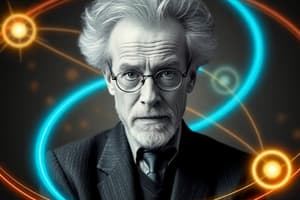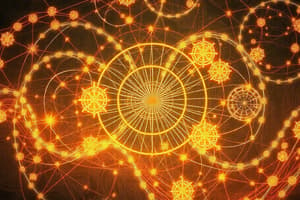Podcast
Questions and Answers
What fundamental problem in quantum mechanics did Feynman address with his diagrams?
What fundamental problem in quantum mechanics did Feynman address with his diagrams?
- The absence of intuitive models to understand particle behavior.
- The lack of visual representation for quantum interactions.
- The limitations in predicting outcomes of events in particle accelerators.
- The frequent occurrence of infinite and nonsensical values in calculations. (correct)
How do Feynman diagrams contribute to our understanding of quantum events?
How do Feynman diagrams contribute to our understanding of quantum events?
- They illustrate the potential paths and interactions of particles like electrons and photons. (correct)
- They visually represent the deterministic nature of quantum mechanics.
- They demonstrate the movement of all particles exclusively through time and space, but not backwards through time.
- They precisely determine the exact energy exchanged in particle interactions.
What was the primary significance of Feynman's refinement of Quantum Electrodynamics (QED)?
What was the primary significance of Feynman's refinement of Quantum Electrodynamics (QED)?
- It led to diagrams successfully depicting electron and photon interactions. (correct)
- It provided a deeper understanding of superfluidity.
- It incorporated Gell-Mann’s Standard Model of particle physics, including fermions and bosons.
- It introduced the concept of partons, a precursor to quarks.
How did Feynman's diagrams assist in scientific progress?
How did Feynman's diagrams assist in scientific progress?
What was Feynman's major contribution to nanotechnology?
What was Feynman's major contribution to nanotechnology?
Feynman improved QED theory, which led to diagrams of electron and photon behaviour. What scientific concept was used to describe this behaviour more succinctly?
Feynman improved QED theory, which led to diagrams of electron and photon behaviour. What scientific concept was used to describe this behaviour more succinctly?
In addition to particle physics, which other domain did Feynman investigate?
In addition to particle physics, which other domain did Feynman investigate?
How did Feynman’s approach to explaining physics differ from the traditional?
How did Feynman’s approach to explaining physics differ from the traditional?
What was Murray Gell-Mann’s most notable achievement in particle physics?
What was Murray Gell-Mann’s most notable achievement in particle physics?
What key concept did Gell-Mann introduce to establish the Standard Model?
What key concept did Gell-Mann introduce to establish the Standard Model?
Flashcards
Feynman Diagrams
Feynman Diagrams
Visual representations of particle interactions in quantum mechanics, showing paths of particles like electrons and photons.
Quantum Electrodynamics (QED)
Quantum Electrodynamics (QED)
A theory that describes how light and matter interact, significantly improved by Feynman's work.
Quantum Probabilities
Quantum Probabilities
The ranges of possible outcomes in quantum mechanics, often depicted with Feynman diagrams.
Photons
Photons
Signup and view all the flashcards
Electrons
Electrons
Signup and view all the flashcards
Superfluidity
Superfluidity
Signup and view all the flashcards
Murray Gell-Mann
Murray Gell-Mann
Signup and view all the flashcards
Standard Model
Standard Model
Signup and view all the flashcards
Quarks
Quarks
Signup and view all the flashcards
Nanotechnology
Nanotechnology
Signup and view all the flashcards
Study Notes
Feynman's Quantum Mechanics
- Feynman believed nobody truly understands quantum mechanics
- He felt that the equations and diagrams were too complex
- Quantum equations and diagrams were often too difficult to visualize
- Feynman diagrams are shorthand for complex equations, used by physicists to describe particle interactions in complex systems
- Feynman contributed significantly to the understanding and application of quantum electrodynamics (QED)
- His diagrams greatly aided in clarifying the interactions of electrons and photons in both time and space
- The diagrams could show particles moving backwards in time
- Probabilities of various events could be added together
Feynman's Impact on Physics
- Feynman diagrams aided quantum theory
- His theories were fundamental in the development of the Standard Model
- He made advancements in theories of particle physics
- He helped to explore and explain the behavior of particles at the smallest levels
- Feynman developed the theory of 'partons'
Feynman's Impact on Other Fields
- Feynman contributed to the understanding and applications of nanotechnology and superfluidity
- He theorized about the possibility of quantum computing, understanding why helium flows without viscosity (internal friction) at absolute zero
- Feynman participated in investigating the Challenger disaster, offering insight into the accident's cause
Gell-Mann's Contributions
-
Gell-Mann developed a model for classifying subatomic particles
-
In 1964, he created a model to classify different types of subatomic particles
-
He focused on fermions (matter particles) and bosons (force-carrying particles)
-
Identified the hypothetical unit "quark" as a fundamental particle building block of matter, forming hadrons
-
His ideas, and the later experimental proof, led to the "Standard Model" of particle physics
Studying That Suits You
Use AI to generate personalized quizzes and flashcards to suit your learning preferences.





